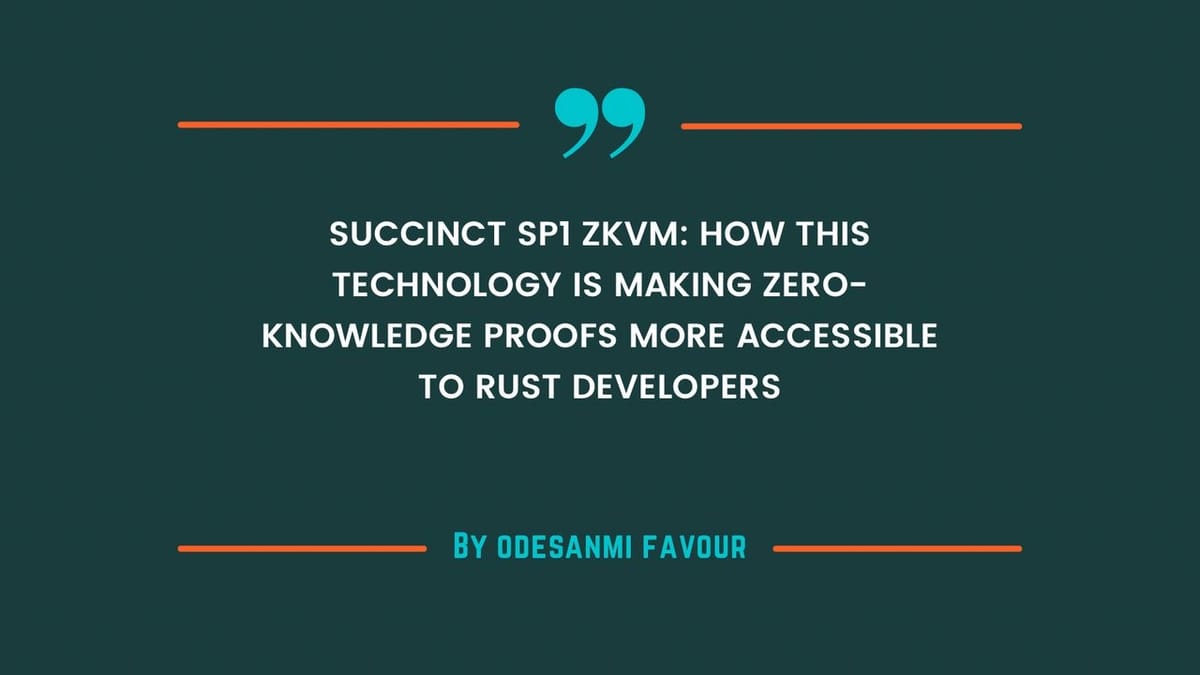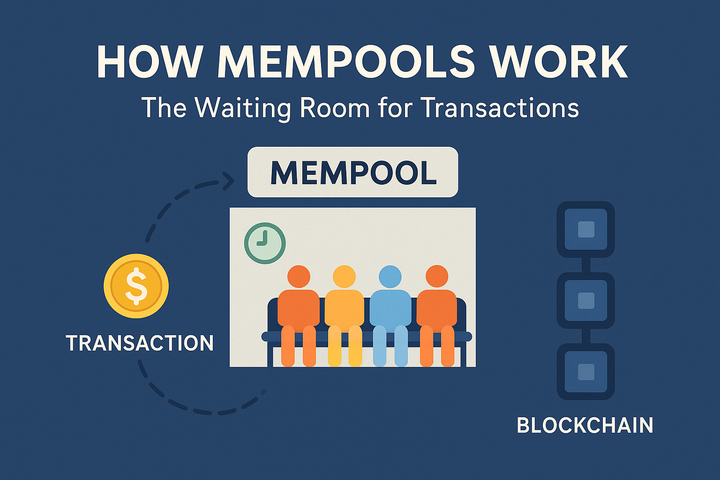Succinct SP1 zkVM: How This Technology Is Making Zero-Knowledge Proofs More Accessible to Rust Developers

Introduction
Zero-Knowledge Proofs (ZKPs) are a cryptographic breakthrough, enabling privacy, scalability, and verifiability in blockchain applications. From secure cross-chain bridges to private decentralized finance (DeFi) protocols, ZKPs promise to redefine Web3. However, their adoption has been hampered by complexity, requiring developers to master esoteric mathematical constructs or custom circuit designs. Succinct Processor 1 (SP1), a zero-knowledge virtual machine (zkVM), is changing this landscape by empowering Rust developers to build ZKP-based applications using familiar tools and workflows. By leveraging Rust’s robust ecosystem, delivering unmatched performance, and integrating seamlessly with blockchain infrastructure, SP1 is democratizing ZKPs, making them accessible to a broader developer community.
In this article, we would explore:
1. Simplifying ZKP Development with Rust’s Familiar Ecosystem
2. Boosting Performance with Precompiles and Open-Source Innovation
3. Enabling Seamless Blockchain Integration for Scalability and Privacy
Simplifying ZKP Development with Rust’s Familiar Ecosystem
Historically, ZKP development has been a niche domain, demanding expertise in cryptographic frameworks like Halo2 or custom arithmetic circuits. This steep learning curve excluded many developers, limiting ZKP adoption. SP1 eliminates these barriers by allowing developers to write ZKP programs in Rust, a language celebrated for its safety, performance, and vibrant ecosystem. Unlike other zkVMs that require bespoke languages or restricted subsets, SP1 supports Rust’s standard library and popular crates like revm, alloy, and tendermint-rs. This enables developers to reuse existing, audited codebases, focusing on application logic rather than cryptographic intricacies.
By embedding ZKP development within Rust’s ecosystem, SP1 transforms a once-daunting process into a familiar workflow. Developers can use tools like Cargo for dependency management, write unit tests with Rust’s testing framework, and audit code with established linters. This integration not only reduces development time but also enhances code reliability, as projects inherit the security guarantees of Rust’s type system and memory safety. For Rust developers, SP1 is a gateway to ZKP development without the cryptographic overhead.
For Example : building a zero-knowledge Ethereum Virtual Machine (zkEVM) is a daunting task, often requiring months of specialized engineering to design circuits that verify Ethereum’s execution environment. With SP1, developers can integrate the Reth crate—a high-performance Ethereum node implementation in Rust—to verify block execution. The Rust code is compiled into a RISC-V ELF file, which SP1 processes to generate a STARK proof of correct execution. This approach allowed OP Succinct to deploy a Type-1 zkEVM on the OP Stack, achieving full Ethereum equivalence with significantly reduced development time. By writing standard Rust code, developers bypassed the need for custom circuit design, completing the project in weeks rather than months. The resulting zkEVM supports Ethereum’s entire instruction set, enabling verifiable computation for smart contracts without sacrificing compatibility.
Boosting Performance with Precompiles and Open-Source Innovation
Performance is a critical factor in ZKP adoption, as slow proof generation and high computational costs can render applications impractical. SP1 addresses this with a precompile-centric architecture and open-source design, delivering proof generation up to 28x faster than competing zkVMs like RISC Zero for certain blockchain workloads. Precompiles optimize computationally intensive operations—such as sha256, keccak256, secp256k1, and ed25519 signature verification—reducing RISC-V cycle counts by 5-10x. This efficiency translates to lower proving costs, making ZKPs viable for high-throughput applications.
SP1’s open-source nature further amplifies its performance advantages. The community-driven model encourages contributions, allowing developers to implement custom precompiles tailored to specific use cases. For instance, teams like Argument and Scroll have contributed precompiles optimized for rollups and light clients, reducing cycle counts and enabling proof costs as low as $0.01-$0.02 per transaction on OP Mainnet. These optimizations have made SP1 an industry standard, influencing other zkVMs like RISC0, Valida, and Nexus. The collaborative ecosystem ensures that SP1 remains at the forefront of ZKP performance, with continuous improvements driven by real-world deployments.
This performance edge is not just theoretical—it’s production-ready. SP1 has undergone rigorous audits by firms like Veridise, Cantina, and KALOS, earning the trust of top blockchain projects. Its ability to generate proofs quickly and cost-effectively is transforming ZKPs from a research curiosity into a practical tool for Web3 applications. For Rust developers, SP1’s performance optimizations mean they can build scalable, cost-efficient solutions without sacrificing speed or security.
For Example: Polygon’s AggLayer uses SP1 to generate pessimistic proofs for secure cross-chain interoperability. Pessimistic proofs assume potential faults in cross-chain messages, requiring robust verification of blockchain states. SP1’s precompiles streamline these cryptographic operations, enabling Polygon to secure over $1 billion in total value locked (TVL) with proofs that rival the efficiency of custom circuits. By minimizing cycle counts, SP1 reduces the computational resources needed, lowering costs and enhancing scalability for Polygon’s ecosystem of interconnected blockchains.
Enabling Seamless Blockchain Integration for Scalability and Privacy
SP1’s versatility lies in its ability to integrate with major blockchains, making it a powerful tool for building scalable and private applications. Its STARK-based proofs are compact and efficient, verifiable on Ethereum for approximately 275,000 gas via STARK-to-SNARK wrapping. This low verification cost, combined with compatibility with ecosystems like Solana, Cosmos, and Celestia, enables developers to deploy ZKPs across diverse blockchain environments. Whether for rollups, bridges, or privacy-focused applications, SP1 empowers Rust developers to enhance blockchain infrastructure.
On Solana, SP1’s verifier enables privacy-focused applications, such as zero-knowledge Know Your Customer (ZK KYC) or confidential automated market makers (AMMs). For example, developers can write Rust code to prove a user’s identity credentials—such as age or accreditation—without revealing sensitive data. Using the sp1_solana crate, these proofs are verified on-chain, ensuring privacy while maintaining Solana’s high throughput. This capability is unlocking new use cases in DeFi, where privacy is critical for adoption. By providing a Rust-based workflow, SP1 makes it easy for Solana developers to incorporate ZKPs into their applications, broadening the scope of privacy-preserving blockchain solutions.
SP1’s integration with other ecosystems, like Cosmos and Celestia, further showcases its flexibility. Projects like Avail use SP1 to generate proofs for data availability, ensuring that rollup data is accessible without compromising security. These integrations highlight SP1’s role as a universal ZKP platform, capable of bridging disparate blockchain networks. For Rust developers, this means they can build interoperable, scalable, and private applications without being locked into a single ecosystem.
For Example: OP Succinct uses SP1 to transform Optimism rollups into ZK rollups. Optimism’s fraud-proof system imposes a 7-day challenge period, delaying transaction finality. By integrating SP1, developers write Rust programs to generate proofs for batch blocks, verifying their correctness in a single ZKP. These proofs are verified on Ethereum, eliminating the fraud-proof window and enabling instant finality. The process is both efficient—costing just 275k gas per verification—and developer-friendly, as it leverages Rust’s ecosystem for implementation. This has made OP Succinct a pioneer in ZK rollups, enhancing scalability and user experience for Optimism’s ecosystem.
Conclusion
Succinct SP1 zkVM is a transformative force in ZKP development, making this powerful technology accessible to Rust developers through a familiar, high-performance, and blockchain-integrated platform. By simplifying development with Rust’s ecosystem, SP1 eliminates the need for specialized cryptographic expertise, as seen in projects like OP Succinct’s zkEVM and Tendermint light clients. Its precompile-centric architecture and open-source innovation deliver unmatched performance, enabling cost-effective proofs for applications like Polygon’s AggLayer. Finally, SP1’s seamless integration with blockchains like Ethereum, Solana, and Cosmos empowers developers to build scalable and private infrastructure, from ZK rollups to confidential DeFi protocols.
With production-ready audits and adoption by industry leaders, SP1 is not just a tool but a catalyst for Web3’s future. For Rust developers, it offers a gateway to ZKP development without the complexity, enabling them to create verifiable, scalable, and private applications with ease. As blockchain adoption grows, SP1 is poised to drive the next wave of innovation, proving that ZKPs can be both powerful and accessible.



Comments ()